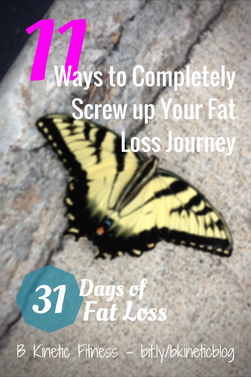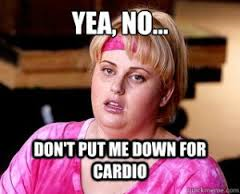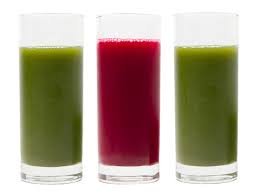There are literally thousands of ways to transform your body — weightlifting, Crossfit, running, Paleo, carb-cycling, triathlons, walking, If It Fits Your Macros (IIFYM), kickboxing, Body Pump…. The list goes on and on. While we can certainly debate the finer points of each modality and diet, we can all agree that there are a few things that can definitely derail your progress and ability to maintain your results.
1. Try to go it alone, without support.
Whether this is a coach, a workout buddy, or general family support, it is absolutely crucial to your success. A lack of support makes everything that much harder. It’s not easy to eat your grilled chicken breast and salad when your significant other is always chowing down on a juicy cheeseburger and French fries.
Even if your loved ones don’t put any overt pressure on you to eat like them, it can be uncomfortable and difficult to stay the course when everyone around you is throwing caution to the wind. Being around people who understand your struggles and are willing to lend a hand in helping you make the best choices despite temptation is a big piece of the puzzle that most people tend to completely overlook. And for some, having some kind of external accountability in the form of a workout buddy or daily email check-in is very beneficial.
2. Do too much too soon and make things unnecessarily complicated.
Keep it simple, people! Only do the minimum needed to see changes. Then every time you hit a plateau, you have something left in your training and diet toolbox to use. If you drop your calories and carbs too low and do a ton of cardio right from the get-go, your body will adapt, and then you can only do so much cardio and go so low with calories without serious negative consequences. And there is also absolutely no need to go from zero lifting to lifting 5-6 days a week for 90+ minutes. Start with 2 or 3 days of full body workouts of 30 minutes each and start with the basics. You will still get great results. Your body will thank you, and you’ll be less likely to burnout or get injured.
3. Only do cardio with no weight training.
Because #muscles. Because without weight training, you’ll burn a significant amount of muscle along with body fat. If/when you gain the weight back, you’ll be worse off, because now you have even less lean body mass than before, so your body fat percentage will be higher. And weights reshape and tighten your body in a way that cardio alone can’t. It’s common to get caught up in the calorie-counting game, but physique transformation isn’t all about burning calories. It’s also about building muscle, balancing hormones, and progressively overloading the body so that it is forced to respond. For more reasons how you can benefit from weight training, see my post here.
4. Focus too much on scale weight.
Being borderline obsessed with hitting a certain arbitrary number on the scale is useless. You may be trying to hit a weight that you were a few years ago, but your body has changed in that time period, so that may no longer be a realistic number. And letting the scale have so much control over your emotions that it determines whether or not today is a good day or a bad day — so not worth it. Your goal body composition/shape may be a lower or higher weight than you realize.
And there are so many factors that can affect the number that shows up on the scale: w
ater retention, food you’ve eaten, liquids you’ve consumed, whether or not you’ve had a bowel movement, over-the-counter and prescription meds, salty meals you’ve eaten, the workout recovery process, stress levels, and more. It’s just not a reliable measure of progress. Sure, it can give you a data point to track, but it’s not the be all, end all. When it comes down to it, body composition (percentage of body fat relative to lean body mass), and even circumference measurements, are a much more relevant measure of results. And even those should be taken with a grain of salt at times.5. Eat only processed diet food with very few veggies.
It’s so tempting to do the easy thing and buy nothing but Lean Cuisines, protein bars, and shakes. The calories are already calculated, portion sizes are taken care of, no cooking or chopping needed. This can become a trap, though, because it makes it that much harder to eat “regular” food once you hit your goal without gaining the weight back. You have no frame of reference as far as proper portion sizes and calorie counts, and you end up missing out on all that great nutrition. These kind of foods can be fine in a pinch, but the bulk of your diet should be made up of low starch veggies like leafy greens, celery, broccoli, cauliflower, leeks, cucumbers, bok choy, and bell peppers. They provide a ton of nutrition, are low in calories, and fill you up because of their high fiber and water content (volume for the win!).
6. Do a juice cleanse or other dubious crash diet fad.
Warning: rant ahead! This drives me crazy like nothing else. This is not the way to “jump start” a healthy lifestyle or fat loss. There is nothing healthy about eating starvation-level calories and cutting out entire food groups. It’s a fantastic way to lose lean muscle and decrease your metabolic rate, as well as cause a hormonal imbalance and cause cravings to skyrocket (I don’t care who you are, you’re going to give in at some point). I’ve seen this over and over and over. I’ve never seen anyone who used a crash diet or cleanse to “jump start their healthy lifestyle” and actually maintained their weight loss or look leaner than they did before. Not one single time.
Let’s say you lose 20 lbs. in 30 days on one these things. I’ll be willing to bet that half of that is muscle (but most likely much more). So now your metabolism has dropped significantly in response to the super low calorie intake and loss of muscle. And let’s say you gain just 10 lbs. of that back when you return to your old eating habits (or even modified healthy ones). Without that other 10 lbs. of lost muscle, your body composition is worse off than when you started, even though you’re still 10 lbs. lighter than your starting weight. Your clothes won’t fit any better, you won’t be any more “toned”, and you won’t be any tighter or less soft than before. And you certainly will not be any healthier, despite being 10 lbs. lighter. If you do this again and again, which is pretty common, you can guess how it ends. (Not good.) Just say no.
7. Follow a cookie-cutter meal plan.
One of those one-size-fits-all meal plans from lazy coaches and from magazines don’t take anything about you into account — height, weight, body composition, training schedule, lifestyle, food preferences, metabolic rate, etc. Sure it might work for a while, but it’s not a long-term solution and doesn’t allow for flexibility for those times when you can’t take your diet food with you everywhere you go. There will inevitably be times when you have to make the best of what’s available to you, and a strict meal plan leaves you feeling panicked and stressed because you can’t eat what’s on your plan. We don’t live in a perfect world, and we are not perfect people, so expecting to follow a strict meal plan is setting ourselves up for failure. A strict meal plan makes us feel like we’re either “on” our diet or “off” (and then all bets are off!). This kind of black-and-white thinking always ends up being nothing.
8. Be inconsistent.
With diet, exercise, sleep, everything. Our goal should be to shoot for 80-90% compliance 100% of the time, which always beats 100% every once in a while. A slip-up or skipped workout isn’t the end of the world, but if it happens too frequently, you will not see the results you’re after. Going 100% strict Monday through Thursday and then blowing it all weekend doesn’t work. And it’s a terrible long-term strategy.
9. Let stress get out of control.
Out of whack stress hormones re
ally do a number on both recovery from workouts and the fat-burning process. It has a domino effect as well: unmanaged stress => crappy sleep => more cravings, insatiable appetite => overeating, poor food choices => weight gain => more stress.
Cortisol (one of the most commonly known stress hormones) is one of those things where the devil in the dose. Our bodies need cortisol to prime our bodies for dangerous situations (fight or flight), for optimal performance (that big presentation at work), and to build muscle. But let cortisol get out of control and be constantly elevated, and it signals our bodies to store fat instead. This is why I encourage my clients to include leisure walks, yoga, and other restorative activities throughout the week. This can be just as important as diet and exercise to fat loss.
Stress is more than just your insane workload, family drama, or your never-ending to-do list — it also includes cutting calories and carbs, sleep deprivation, lack of recovery/rest throughout the day, strenuous workouts, and excess caffeine. Even “good” stress can overload the body to the point of breakdown. That’s why it’s especially important to vary the intensity and duration of your workouts, moderate your caffeine intake, and be as conservative as possible with calorie- and carb-cutting.
10. Skimp on sleep.
I’m totally guilty of this one. As mentioned above, sleep elevates stress hormones and can cause cravings and decrease satiety due to the imbalance of leptin and ghrelin. Not to mention that your workouts will suffer due to low energy. Check out this article from Strengtheory.com on sleep and its effects on weight loss here. According to author Greg Nuckols, sleep deprivation (according to the study he cites) will cause more lean tissue loss, less fat loss, and more carbs than fat to be burned as fuel. So even if you do everything right with training and nutrition, you can still struggle to lose fat and hold on to lean muscle. Add to that the impairment of recovery from a lack of sleep.
11. Give no thought to what happens after you reach your goal weight/size.
Trust me, it’s really, really easy to let up on your healthy eating habits once you hit your goal. You start thinking, “This one meal won’t hurt me” and “This one dessert won’t affect me” and before you know it, you’re back to the old eating patterns that made you gain weight in the first place. It’s a slippery slope if you aren’t prepared for the end of your diet with a solid plan in place. Likely your metabolic rate has dropped a bit from losing weight (completely normal) and you need to take this into consideration. One effective method is called “reverse dieting.” You may have seen it mentioned on social media or on blogs. It simply refers to gradually adding back calories (and maybe carbs) over a period of time until you hit maintenance level.
While there are many ways to get your goals, doing too many of the wrong things can prevent you from actually reaching them, causing frustration and disappointment. By avoiding the mistakes above, you are giving yourself a better than good chance at success. Remember, we’re taking the long view. We want to see results, yes, but we also want to maintain them in a healthy, sustainable manner that allows us to enjoy our lives without deprivation. And that means taking things slowly and being methodical in the way we approach our training and diet.




